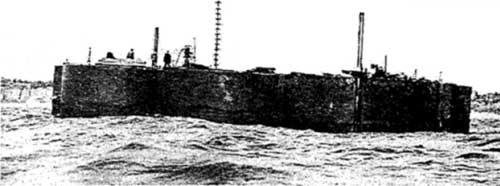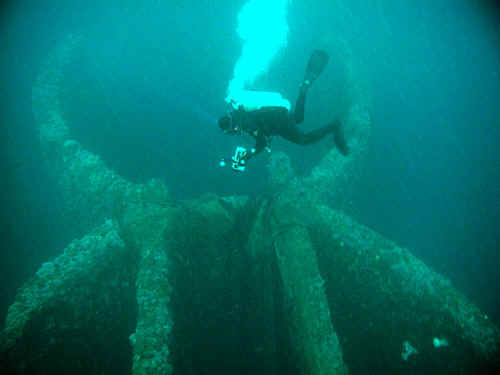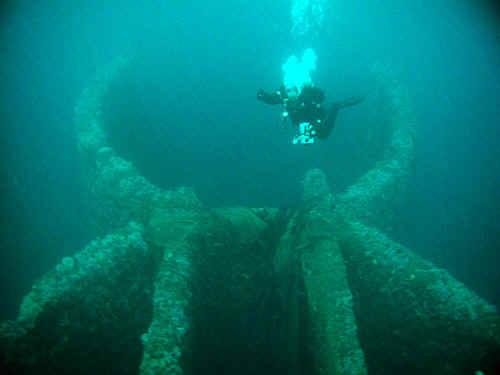Caissons
| Other Names: | Date of Sinking: May 27, 1935 | |||
| Rig/Type: Ferro-Cement "Crib" | Cause of Sinking: Intentional Sinking (disposal) | |||
| Length: 111' | Breadth: 35' | Tons: 2,000 | Cargo: None | |
| Built: Unknown | Location: South of Pt. Fermin | |||
| Hull Construction: Ferro-cement | Depth: 140-160' | Visibility: 15-50' | ||
|
In 1931, the City of Santa Monica voted to construct a breakwater in front of the Santa Monica Pier, allowing small craft to safely anchor in a small yacht harbor. The following, a contract was awarded to the Puget Sound Bridge and Dredging Co. to build individual "cribs"--large sections consisting of three cylinders each that would be assembled in line to form a breakwater. Each crib was to measure 111' in length, 36' in height and 35' wide. On March 10 of 1933, the first crib was launched out of a Long Beach dry-dock and towed into place off the Santa Monica pier.
The first crib or caisson is towed from Long Beach to Santa Monica However, the sandy bottom was an inadequate foundation for the caisson and it soon came tumbling down in the surf like a sand castle. What remained was dynamited April 27. Santa Monica began construction of a breakwater during the summer of 1933 consisting of rock quarried from Catalina. The breakwater was completed in July of 2004, but it too faired poorly in the surf and broke apart in the years to follow. Parts of it can be seen today. By the end of May, 1935 the Puget Sound Bridge and Dredging Co. completed its work on the Santa Monica and Los Angeles breakwater extension and dismantled its shipyard in Long Beach. On the 27th, the two remaining caissons were towed out and sunk. Seven years later, one of the caissons was discovered by the destroyer, USS Gilmer. On February 14, 1942, the Gilmer identified one of the caissons as a potential enemy threat and dropped eight depth charges. The history of the caissons remained unknown until Gary Fabian identified these unknown structures through archival research.
A diver descends to one of the caissons.
A similar shot, providing the scale for the size of the caissons. Photos courtesy of Phil Garner. Diving The Caissons Most wrecks off Southern California are broken up and as a result, have a low profile. It is unusual to find a structure that rises vertically nearly 40' off the bottom. It is also an unusual, yet fascinating experience to descend into a large pipe, some 35' in diameter. Despite their 70 years underwater, the growth is minimal and there is little silt or sand in the bottom of the cylinders. |
||||
| Like to learn more about this wreck? Visit our Guest Page to submit your inquiry. |



